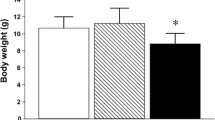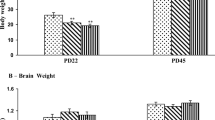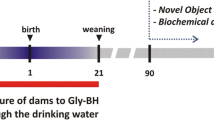Abstract
Early life exposure to environmental pollutants and toxic chemicals has been linked to learning and behavioral alterations in children. iAs exposure is associated with different types neurological disorders such as memory and learning impairment. iAs is methylated in the brain by the arsenic III-methyltransferase in a process that requires glutathione (GSH). The xCT-antiporter cell membrane transporter participates in the influx of cystine for GSH synthesis in exchange for glutamate in a 1:1 ratio. In CD-1 mice gestationally exposed to 20 ppm of sodium arsenite in drinking water, we have previously observed up-regulation of xCT in the male mouse hippocampus which caused glutamatergic synapse alterations affecting learning and memory processes. Here, we used the same gestational iAs exposure model to investigate whether the up-regulation of xCT and down-regulation of GLT-1 transporters were associated with higher levels of extracellular glutamate and changes in the expression of the α-amino-3-hydroxy-5-methyl-4-isoxazolepropionic acid (AMPA) glutamate receptor, responsible for excitatory fast synaptic transmission. The induction of LTP in the perforant–dentate gyrus pathway (PP–DG) of the hippocampus was also studied, as well as learning and memory formation using the water maze test. Changes in GSH levels were also tested in the hippocampus of animals exposed to iAs. Results showed increased GSH synthesis (p < 0.05), associated with significantly higher extracellular glutamate levels in iAs exposed mice. Exposure was also significantly associated with AMPA subunits down-regulation, deficient LTP induction, and lower excitability of the PP–DG pathway. In addition, animals showed deficient learning and memory in the Morris Water Maze test.





Similar content being viewed by others
Abbreviations
- AdoMet:
-
S-Adenosylmethionine
- AMPA:
-
α-Amino-3-hydroxy-5-methyl-4-isoxazolepropionic acid
- As3MT:
-
Arsenic III-methyltransferase
- BBB:
-
Blood–brain barrier
- DG:
-
Dentate gyrus
- EPSP:
-
Excitatory post-synaptic potential
- GSH:
-
Glutathione
- iAs:
-
Inorganic arsenic
- LTP:
-
Long-term potentiation
- NMDA:
-
N-Methyl-d-aspartate
- OPA:
-
o-Phthalaldehyde
- PND:
-
Post-natal day
- PP:
-
Perforant pathway
- PP–DG:
-
Perforant–dentate gyrus pathway
- PPF:
-
Paired-pulse facilitation
- RRP:
-
Relative refractory periods
- TG:
-
Total GSH
- WHO:
-
World Health Organization
References
Ahmed S, Akhtar E, Roy A et al (2017) Arsenic exposure alters lung function and airway inflammation in children: a cohort study in rural Bangladesh. Environ Int 101:108–116. https://doi.org/10.1016/j.envint.2017.01.014
Arriaza B, Amarasiriwardenad D, Cornejob L et al (2010) Exploring chronic arsenic poisoning in pre-Columbian Chilean mummies. J Archaeol Sci 37:1274–1278. https://doi.org/10.1016/j.jas.2009.12.030
Asadullah MN, Chaudhury N (2008) Poisoning the mind: arsenic contamination and cognitive achievement of children. World Bank Policy Research Working Paper
Bear Mark F., Barry W, Connors, Paradiso Michael A. (2007) Neuroscience: Exploring the brain, 3rd edn. Lippincott, Philadelphia
Béïque JC, Na Y, Kuhl D et al (2011). Arc-dependent synapse-specific homeostatic plasticity. Proc Natl Acad Sci USA 108(2):816–821. https://doi.org/10.1073/pnas.1017914108
Bennett D, Bellinger DC, Birnbaum LS et al (2016) Project TENDR: targeting environmental neuro-developmental risks. The TENDR Consensus Statement. Environ Health Perspect 124:A118–A122. https://doi.org/10.1289/EHP358
Brady ST, Siegel GJ, Albers RW et al (2012) Basic neurochemistry, principles of molecular, cellular, and medical neurobiology, 8th edn. Elsevier, Boston
Bridges R, Lutgen V, Lobner D et al (2012) Thinking outside the cleft to understand synaptic activity: contribution of the cystine–glutamate antiporter (System xc-) to normal and pathological glutamatergic signaling. Pharmacol Rev 64(3):780–802. https://doi.org/10.1124/pr.110.003889
Calderón J, Navarro ME, Jimenez-Capdeville ME (2001) Exposure to arsenic and lead and neuropsychological development in Mexican children. Environ Res 85(2):69–76. https://doi.org/10.1006/enrs.2000.4106
Concha G, Vogler G, Lezcano D et al (1998) Exposure to inorganic arsenic metabolites during early human development. Toxicol Sci 44:185–190
De Bundel D, Schallier A, Loyens E et al (2011) Loss of system x(c)—does not induce oxidative stress but decreases extracellular glutamate in hippocampus and influences spatial working memory and limbic seizure susceptibility. J Neurosci 31:5792–5803. https://doi.org/10.1523/JNEUROSCI.5465-10.2011
Del Razo L, García-Vargas G, Vargas H et al (1997) Altered profile of urinary arsenic metabolites in adults with chronic arsenicism. A pilot study. Arch Toxicol 71(4):211–217
Devesa V, Adair B, Liu J et al (2006) Arsenicals in maternal and fetal mouse tissues after gestational exposure to arsenite. Toxicology 224:147–155. https://doi.org/10.1016/j.tox.2006.04.041
Du J, Creson T, Wu L et al (2009) The role of hippocampal GluR1 and GluR2 receptors in manic-like behavior. J Neurosci 28(1):68–79. https://doi.org/10.1523/JNEUROSCI.3080-07.2008
Farooqui AA, Ong WY, Horrocks LA (2008) Neurochemical aspects of excitotoxicity. Springer Science, Business Media, New York, pp 1–32
García-Vargas G, García-Rangel A, Aguilar-Romo M et al (1991) A pilot study on the urinary excretion of porphyrins in human populations chronically exposed to arsenic in Mexico. Hum Exp Toxicol 10(3):189–193
Groc L, Choquet D (2006) AMPA and NMDA glutamate receptor trafficking: multiple roads for reaching and leaving the synapse. Cell Tissue Res 326:423–438. https://doi.org/10.1007/s00441-006-0254-9
Herring B, Nicoll R (2016) Long-term potentiation: from CaMKII to AMPA receptor trafficking. Annu Rev Physiol 78:351–365. https://doi.org/10.1146/annurev-physiol-021014-071753
Huang Y, Yang S, Hu Z et al (2012) A new approach to location of the dentate gyrus and perforant path in rats/mice by landmarks on the skull. Acta Neurobiol Exp (Wars) 72(4):468–472
Huo T, Zhang Y, Li W et al (2014) Effect of realgar on extracellular amino acid neurotransmitters in hippocampal CA1 region determined by online microdialysis—dansyl chloride derivatization—high-performance liquid chromatography and fluorescence detection. Biomed Chromatogr 28(9):1254–1262. https://doi.org/10.1002/bmc.3154
Huo T, Li W, Zhang Y et al (2015) Excitotoxicity induced by realgar in the rat hippocampus: the involvement of learning memory injury, dysfunction of glutamate metabolism and NMDA receptors. Mol Neurobiol 51(3):980–994. https://doi.org/10.1007/s12035-014-8753-2
Jin Y, Wang G, Zhao F et al (2010) Distribution of speciated arsenicals in mice exposed to arsenite at the early life. Ecotoxicol Environ Saf 73:1323–1326. https://doi.org/10.1016/j.ecoenv.2010.02.012
Kapaj S, Peterson H, Liber K et al (2006) Human health effects from chronic arsenic poisoning—a review. J Environ Sci Health 41(10):2399–2428. https://doi.org/10.1080/10934520600873571
Krüger K, Straub H, Hirner AV et al (2009) Effects of monomethylarsonic and monomethylarsonous acid on evoked synaptic potentials in hippocampal slices of adult and young rats. Toxicol Appl Pharmacol 236(1):115–123. https://doi.org/10.1016/j.taap.2008.12.025
Lanphear B (2015) The impact of toxins on the developing brain. Annu Rev Public Health 36:211–230. https://doi.org/10.1146/annurev-publhealth-031912-114413
Lewerenz J, Maher P (2015) Chronic glutamate toxicity in neurodegenerative diseases-what is the evidence? Front Neurosci 9:469. https://doi.org/10.3389/fnins.2015.00469
Luo J, Qiu Z, Shu W et al (2009) Effects of arsenic exposure from drinking water on spatial memory, ultra-structures and NMDAR gene expression of hippocampus in rats. Toxicol Lett 184(2):121–125. https://doi.org/10.1016/j.toxlet.2008.10.029
Luo J, Qiu Z, Zhang L et al (2012) Arsenite exposure altered the expression of NMDA receptor and postsynaptic signaling proteins in rat hippocampus. Toxicol Lett 211:39–44. https://doi.org/10.1016/j.toxlet.2012.02.021
Maekawa F, Tsuboi T, Oya M et al (2013) Effects of sodium arsenite on neurite outgrowth and glutamate AMPA receptor expression in mouse cortical neurons. Neurotoxicology 37:197–206. https://doi.org/10.1016/j.neuro.2013.05.006
Massie A, Schallier A, Kim SW et al (2011) Dopaminergic neurons of system x(c)(–)-deficient mice are highly protected against 6-hydroxydopamine-induced toxicity. FASEB J 25:1359–1369. https://doi.org/10.1096/fj.10-177212
Mayer ML, Westbrook GL (1987) The physiology of excitatory amino acids in the vertebrate central nervous system. Prog Neurobiol 28(3):197–276
McClintock T, Chen Y, Bundschuh J et al (2012) Arsenic exposure in Latin America: biomarkers, risk assessments and related health effects. Sci Total Environ 429:76–91. https://doi.org/10.1016/j.scitotenv.2011.08.051
Mejía-Toiber J, Márquez-Ramos JA, Díaz-Muñoz M et al (2010) Glutamatergic excitation and GABA release from a transplantable cell line. Cell Transplant 19:1307–1323. https://doi.org/10.3727/096368910X509059
O’Bryant SE, Edwards M, Menon CV et al (2011) Long-term low-level arsenic exposure is associated with poorer neuropsychological functioning: a Project FRONTIER study. Int J Environ Res Public Health 8(3):861–874. https://doi.org/10.3390/ijerph8030861
Orlandi C, La Via L, Bonini D et al (2011) AMPA receptor regulation at the mRNA and protein level in rat primary cortical cultures. PLoS One 6(9):e25350. https://doi.org/10.1371/journal.pone.0025350
Osorio-Yáñez C, Ayllon-Vergara J, Arreola-Mendoza L et al (2015) Blood pressure, left ventricular geometry, and systolic function in children exposed to inorganic arsenic. Environ Health Perspect 123(6):629–635. https://doi.org/10.1289/ehp.1307327
Parajuli RP, Fujiwara T, Umezaki M et al (2013) Association of cord blood levels of lead, arsenic, and zinc with neurodevelopmental indicators in newborns: a birth cohort study in Chitwan Valley. Nepal Environ Res 121:45–51. https://doi.org/10.1016/j.envres.2012.10.010
Prakash C, Soni M, Kumar V (2015) Biochemical and molecular alterations following arsenic-induced oxidative stress and mitochondrial dysfunction in rat brain. Biol Trace Elem Res 167(1):121–129. https://doi.org/10.1007/s12011-015-0284-9
Ramos-Chávez LA, Rendón-López CR, Zepeda A et al (2015) Neurological effects of inorganic arsenic exposure: altered cysteine/glutamate transport, NMDA expression and spatial memory impairment. Front Cell Neurosci 9:21. https://doi.org/10.3389/fncel.2015.00021. eCollection 2015
Rocha-Amador D, Navarro ME, Carrizales L et al (2007) Decreased intelligence in children and exposure to fluoride and arsenic in drinking water. Cad Saude Publica 23(Suppl 4):S579-587
Rodríguez VM, Del Razo LM, Limón-Pacheco JH et al (2005) Glutathione reductase inhibition and methylated arsenic distribution in Cd1 mice brain and liver. Toxicol Sci 84:157–166. https://doi.org/10.1093/toxsci/kfi057
Rosado JL, Ronquillo D, Katarzyna K (2007) Arsenic exposure and cognitive performance in Mexican schoolchildren. Environ Health Perspect 115:119. https://doi.org/10.1289/ehp.9961
Sánchez-Peña LC, Petrosyan P, Morales M et al (2010). Arsenic species, AS3MT amount, and AS3MT gene expression in different brain regions of mouse exposed to arsenite. Environ Res 110(5):428–434. https://doi.org/10.1016/j.envres.2010.01.007
Schindler J, Jung S, Niedner-Schatteburg G et al (2006) Enrichment of integral membrane proteins from small amounts of brain tissue. J Neural Transm (Vienna) 113(8):995–1013. https://doi.org/10.1007/s00702-006-0508-4
Schlebusch CM, Gattepaille LM, Engström K et al (2015) Human adaptation to arsenic-rich environments. Mol Biol Evol 32(6):1544–1555. https://doi.org/10.1093/molbev/msv046
Schulz P, Cook E, Johnston (1994) Changes in paired-pulse facilitation suggest presynaptic involvement in long-term potentiation. J Neurosci 14(9):5325–5337
Senft AP, Dalton TP, Shertzer HG (2000) Determining glutathione and glutathione disulfide using the fluorescence probe o-phthalaldehyde. Anal Biochem 280(1):80–86. https://doi.org/10.1007/s00702-006-0508-4
Singh V, Gera R, Kushwaha R et al (2016) Hijacking microglial glutathione by inorganic arsenic impels bystander death of immature neurons through extracellular cystine/glutamate imbalance. Sci Rep 6:30601. https://doi.org/10.1038/srep30601
Srivastava P, Dhuriya Y, Gupta R et al (2016) Protective effect of curcumin by modulating BDNF/DARPP32/CREB in arsenic-induced alterations in dopaminergic signaling in rat corpus striatum. Mol Neurobiol. https://doi.org/10.1007/s12035-016-0288-2
Thomas DJ (2007) Molecular processes in cellular arsenic metabolism. Toxicol Appl Pharmacol 222 (3):365–373. https://doi.org/10.1016/j.taap.2007.02.007
Tolins M, Ruchirawat M, Landrigan P (2014) The developmental neurotoxicity of arsenic: cognitive and behavioral consequences of early life exposure. Ann Glob Health 80(4):303–314. https://doi.org/10.1016/j.aogh.2014.09.005
Tsai SY, Chou HY, The HW et al (2003) The effects of chronic arsenic exposure from drinking water on the neurobehavioral development in adolescence. Neurotoxicology 24(4–5):747–753. https://doi.org/10.1016/S0161-813X(03)00029-9
Tyler CR, Allan AM (2013) Adult hippocampal neurogenesis and mRNA expression are altered by perinatal arsenic exposure in mice and restored by brief exposure to enrichment. PLoS One 8(9):e73720. https://doi.org/10.1371/journal.pone.0073720
Tyler CR, Allan AM (2014) The effects of arsenic exposure on neurological and cognitive dysfunction in human and rodent studies: a review. Curr Environ Health Rep 1:132–147. https://doi.org/10.1007/s40572-014-0012-1
Vahter M (2008) Health effects of early life exposure to arsenic. Basic Clin Pharmacol Toxicol 102:204–211. https://doi.org/10.1111/j.1742-7843.2007.00168.x
Valdovinos-Flores C, Gonsebatt ME (2013) The role of amino acid transporters in GSH synthesis in the blood–brain barrier and central nervous system. Neurochem Int 61(3):405–414. https://doi.org/10.1016/j.neuint.2012.05.019
Von Ehrenstein OS, Poddar S, Yuan Y et al (2007) Children’s intellectual function in relation to arsenic exposure. Epidemiology 18:44–51. https://doi.org/10.1097/01.ede.0000248900.65613.a9
Wasserman GA, Liu X, Loiacono N et al (2014) A cross-sectional study of well water arsenic and child IQ in Maine schoolchildren. Environ Health 13:23. https://doi.org/10.1186/1476-069X-13-23
Williams L, Featherstone D (2014) Regulation of hippocampal synaptic strength by glial xCT. J Neurosci 34(48):16093–16102. https://doi.org/10.1523/JNEUROSCI.1267-14.2014
Zhang C, Li S, Sun Y et al (2014) Arsenic downregulates gene expression at the postsynaptic density in mouse cerebellum, including genes responsible for long-term potentiation and depression. Toxicol Lett 228(3):260–269. https://doi.org/10.1016/j.toxlet.2014.05.007
Acknowledgements
We thank Pavel Petrosyan for his technical support and Unidad de Modelos Biológicos, Instituto de Investigaciones Biomédicas, UNAM for supplying the animals. Janikua Nelson-Mora received a scholar fellowship from CONACYT No 384958, and she thanks the Posgrado en Ciencias Biologicas, UNAM for its support. This work received grants from PAPIIT (UNAM) IN 207611, PAPIIT (UNAM) IN 215816 and CONACYT102287 and Red Temática de Salud Ambiental Infantil Conacyt 280296 to María E. Gonsebatt. This study was performed in partial fulfillment of the requirements for the PhD degree in the Posgrado en Ciencias Biológicas at the Universidad Nacional Autónoma de México.
Author information
Authors and Affiliations
Corresponding author
Rights and permissions
About this article
Cite this article
Nelson-Mora, J., Escobar, M.L., Rodríguez-Durán, L. et al. Gestational exposure to inorganic arsenic (iAs3+) alters glutamate disposition in the mouse hippocampus and ionotropic glutamate receptor expression leading to memory impairment. Arch Toxicol 92, 1037–1048 (2018). https://doi.org/10.1007/s00204-017-2111-x
Received:
Accepted:
Published:
Issue Date:
DOI: https://doi.org/10.1007/s00204-017-2111-x




